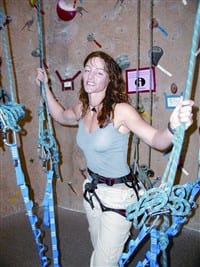Summit Meeting Local Rock Climber Aims High In Bid To Help Fight Against Breast Cancer
Laurie Normandeau has two sizeable challenges in front of her.
The first is Mount Kilimanjaro — all 19,340 feet of it. The second is a commitment to raise $10,000 to combat breast cancer.
Normandeau, a rock climber and teacher of the sport locally, accepted both challenges when she signed on to take part in the Climb to Fight Breast Cancer, a program initiated by the Seattle-based Fred Hutchinson Cancer Research Center that is now in its second year.
Next August, Normandeau and 11 other climbers will take on Kilimanjaro, the tallest mountain in Africa and one of the most rugged climbing challenges to be found anywhere. Meanwhile, between now and then, she must raise $10,000 to fight breast cancer. Whatever she doesn’t raise, according to the terms of her contract, gets put on her credit card.
Normandeau, from Northampton, told The Healthcare News she signed on for the project because it blends her passion for rock climbing with a desire to make worthwhile contributions to fighting cancer, which claimed her mother several years ago.
“I love to climb, and want to do my part to battle breast cancer,” she said. “I saw this and thought it was the perfect opportunity.”
Normandeau is already in training for the assault on Kilimanjaro, which will be an Alpine climb, different in many ways from the ‘top rope’ or ‘lead’ climbing in which she specializes. As for the other obstacle in her path, she said she is still developing strategies for meeting her $10,000 commitment — half of which must be raised by February.
She said she will counting on the generosity of area businesses, as well as individuals who have had their lives impacted by breast cancer.
“I don’t know of anyone who hasn’t had a friend or family member confront breast cancer,” she said. “This is a disease that touches everyone.”
Rock Solid
Normandeau said she started climbing about 16 years ago, when she was introduced to the sport by a friend at an Outward Bound program.
She got hooked on top rope climbing and has since taken on summits on four continents. As she spoke with The Healthcare News, she was preparing to leave for a series of climbs in Joshua Tree National Park in the Mohave Desert as part of another Outward Bound project.
In recent years, she has been at the forefront of the increasingly popular sport of indoor rock climbing, a pastime that has enjoyed steady growth over the past decade or so.
While Northampton’s facility is the only one in Western Mass., there are several indoor ‘rocks’ in New England, including a few in the Boston area and several in Connecticut. The sport now boasts a wide demographic, said Normandeau, noting that it has caught the attention of many young professionals.
“We have lawyers and emergency room doctors doing this,” she said. “But we also have artists and bricklayers. It appeals to a wide range of people, all of whom like the physical aspects of it, but also the teamwork and the social interaction.”
Normandeau said climbing is different from many sports, especially repetitive fitness programs, because it offers participants new challenges. The variety and sense of accomplishment that come with reaching new heights — literally and figuratively — make the sport appealing.
“When people start climbing, they don’t come into it with the intention of getting fit,” she explained. “I think they look at it and say, ‘I want the challenge of making it to the top of the rock.’
“The longer you do it, the more it becomes a workout,” she continued. “When they start out, most people tire out quickly because they don’t have the stamina to hang on. Over time, they build stamina.”
The rock at the Northampton Athletic Club is 40 feet high, with approximately 60 varyingly challenging routes, or “climbs” to the top, said Normandeau, adding that many facilities have taller rocks. One facility built in a silo in Texas is 110 feet high.
At the Northampton rock, there are 23 ropes anchored to the ceiling, each one with at least three paths to the top that are defined by maneuvers over and around clay holds that jut out from the rock and help the climber ascend.
The various color-coded climbs are rated in a manner similar to ski slopes and white-water rafting excursions, she said, with 5.0 denoting the simplest of ascents and 5.15 marking the toughest challenge. The sternest challenge at Northampton’s facility is a 5.13, during which the climber is “hanging on to nothing.”
While top-rope climbing is much different from alpine ascents, the important basics, including teamwork and conditioning, are the same, said Normandeau, who added that her background — coupled with some new training regimens — should leave her well-prepared for Kilimanjaro.
Top of Her Game
Normandeau said she found out about the Climb to Fight Breast Cancer in an ad in one of the many climbing magazines she reads. Intrigued, she made a few phone calls to see if spots on the team remained, and eventually applied. Notification that she had been chosen for the climb was a moment that blended pride in accomplishment with considerable anticipation about the twin challenges ahead.
“I was really happy to be picked,” she said, “but at the same, I had to come with grips with everything I had to do.”
The Hutchinson Center, which launched the program several years ago, originally focused on climbs in the Pacific Northwest — near the cancer center — including Mount Hood, Mount Rainier, and others. The Kilimanjaro climb was added for this past August and immediately became a popular addition.
Located in Tanzania, Kilamanjaro, an extinct volcano, looms over five ecosystems — everything from rainforest to desert to a snow-capped peak. That makes training a stern challenge, said Normandeau, noting that perhaps the most difficult aspect of her preparation is trying to prepare for the extreme altitudes, where the air is extremely thin and breathing is difficult.
“The organizers suggest finding an area where you can climb at least 3,000 feet with 50- to 60-pound packs,” she said, adding that she will likely utilize an area she is familiar with in Jaffrey, N.H. for such exercises. Meanwhile, she plans to undertake a conditioning regimen concentrating on cardiovascular work, strength, stamina, the upper back, legs, and shoulders.
Located near the equator, Kilimanjo poses a unique challenge in that it forces climbers to prepare for many extremes — heat, cold, and high altitudes, said Normandeau. “It has a little of everything … there’s a lot to prepare for.”
The commitment to the Climb to Fight Breast Cancer, in terms of both time and money, is significant, said Normandeau. In addition to the training and the raising of $10,000, participants are also responsible for the round-trip airfare to Africa, Tanzanian and Kenyan visas, meals and lodging outside the listed itinerary, international vaccinations, and even tips and gratuities.
But she looks upon this as a unique opportunity, one that will bring untold personal satisfaction for her and her teammates — and also help move the fight against cancer another step forward.
Peak Performance
Indeed, looking ahead to next August, Normandeau says Kilimanjaro poses perhaps the sternest test of her climbing career.
Finding a cure for breast cancer is an even bigger obstacle, she noted, and in that fight, she is also relying on teamwork.
Those wishing to make donations or to ask questions about the climb can call Normandeau at (413) 585-8500.



